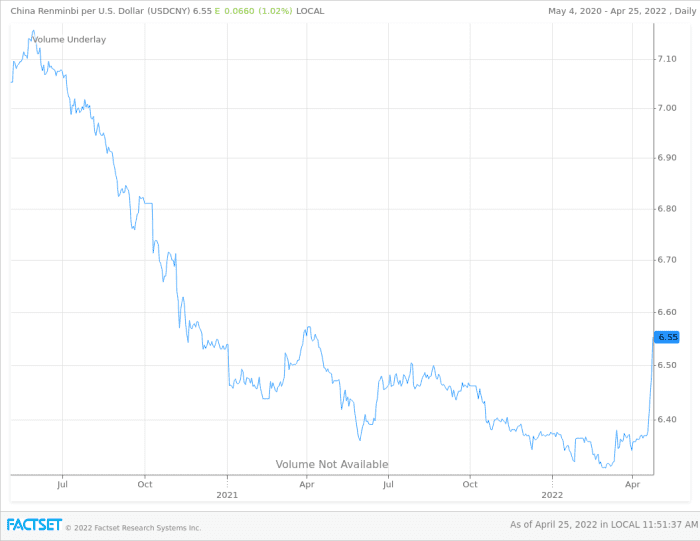This post was originally published on this site
China’s onshore yuan fell to its lowest level in more than two years on Monday amid fears of a citywide lockdown in Beijing, and a continued decline in the Asian currency could potentially trigger more shockwaves across financial markets.
The onshore yuan
CNYUSD,
USDCNY,
which trades within mainland China, fell 0.9% to trade around 6.55 per dollar — on its way to its biggest one-day drop since March 12, 2020, according to Tullett Prebon. The chart below reflects how much China’s renminbi has weakened, with more of the Asian currency needed to trade per dollar.

Source: FactSet
Meanwhile, the People’s Bank of China said it would be cutting its foreign exchange deposit reserve ratio by 1 percentage point, to 8%, as of May 15, to help financial institutions use foreign exchange funds.
“The PBOC’s move revealed a bit of concern about currency weakness,” said Mazen Issa, a senior FX strategist at TD Securities
TD,
in New York. ”The PBOC’s move in and of itself is perhaps not too significant, unless followed by other measures. China’s is a very highly managed exchanged rate compared to a lot of other advanced economies, so you can’t rule out intervention measures.
“Certainly, there’s a lot of concern coming out that these lockdowns are going to impact global trade and the combination of that with a lot of tightening outside China, like in the U.S., will perhaps exacerbate the slowdown that’s expected,” Issa said via phone. “A weaker currency from here could be a signal that perhaps the global growth outlook may be worsening and has the potential to further destabilize the markets.”
Fear of a citywide lockdown in China’s capital ricocheted around global financial markets on Monday. The yuan’s fall came as a gauge of the U.S. dollar hit a two-year high on Monday, with the greenback benefiting from a flight to quality by investors.
Meanwhile, stocks sold off around the world: All three major U.S. stock indexes
DJIA,
COMP,
tumbled alongside commodities such as oil
CL00,
which fell below $100 a barrel on worries about demand. And Treasury yields fell off as investors sought the safety of government bonds, and assessed whether the amount of monetary tightening they expected from the Fed may need to be pared back.
Read: Beijing Braces for Omicron Wave With Stockpiling, Testing
In 2015, the PBOC surprised financial markets with consecutive devaluations of China’s currency — partly to deal with the Asian country’s easing growth — and the moves cascaded through global financial markets as traders worried about a currency war. Such a depreciation was designed to bolster the attractiveness of China’s exports and lead to better growth and trade, in theory.
Now, “certainly there’s a risk that we are going to see additional weakening of the yuan, but I don’t think we’re going to see a devaluation,” TD’s Issa said. TD is projecting that the onshore yuan will depreciate to 6.7 per dollar by the end of next year — with recent moves likely to accelerate that timeline, he said.
“We think China will be interested in projecting stability to its regional Asian peers, and moving toward a significant devaluation of the currency runs counter to that,” he said.


